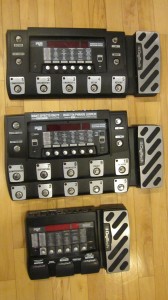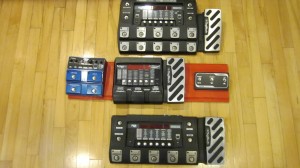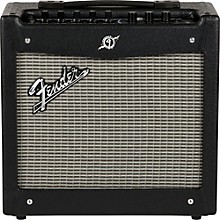
First Thoughts on the RP1000, Updates Soon for the RP500
I’ve acquired my Digitech RP1000, unpacked it, and plugged it in. I have a few immediate impressions.
First, it’s big. Take a look at the picture below: according to Digitech’s published specs, the RP1000 and RP500 are both 2 inches longer than the RP355 (19.5 inches as opposed to 17.5 inches). Looks more like 4 inches than 2 to me. Either way, doesn’t sound like a lot, but it is when it’s sitting on the floor in front of you. (Update: I took out the tape measure and checked the RPs. It turns out that Digitech had the right dimensions for the 500 and 1000–19.5 inches wide–but were way off on the RP355, which is only 12.5 inches wide as opposed to the 17.5 specified in Digitech’s pages on their site. So the RP500 and 1000 are a whopping seven inches wider than the 355. Maybe when they did the RP355 specs, they were thinking about the width of the box it’s sold in.)
The RP1000 is a lot bigger front-to-back than the 500; if you look closely, the RP1000 looks just like a 500 with an extra row of footswitches. The main body of the 1000, which includes the display window and the top row of footswitches, has almost exactly the same dimensions and layout as the 500.

The 500 and 1000 seem even bigger when you consider how much more room either of them takes up on my current RP355-based pedalboard, as shown in the photo. I need a bigger board, that’s all there is to it. Fortunately, that just means getting a longer board, which I’ve already done, painting it red, and putting velcro on it to hold the pedals in place. No biggy.

I’ve also discovered that the RP1000’s output is WAY hotter than the 500 or 355. I’ve checked with Digitech, and according to them this is normal. I dunno. The 1000 with master volume set to 20 is hotter than the RP355 with master volume set to 85. That’s WAY WAY hotter. I’m not sure I get the point; none of the lower RPs ever seemed to lack headroom, so why is the RP1000 so pumped up? But I suppose that’s better than the opposite.
Finally, and very importantly to RP500 and (future) RP1000 Huntersounds patch set licensees, both devices offer a level of control over tone that’s not available in the other RPs. Specifically, they offer amp-modeled EQ–EQ that’s specifically modeled to match the amp (model) that includes it–which makes it much easier to dial in authentic EQ that matches the amp. I expect to use this feature extensively in my next set of patches; first up in that category is a revised set of RP500 patches, which I’ll start pushing out to current RP500 licensees later this month. As this brief description implies, I find this new level of control over the sound of the RP very exciting, and I’m already getting some great results with it.
The RP1000 appears to me to be identical to the RP500 in terms of the FX available and the architecture of the sound engine. (Update: I checked Digitech’s site, and the 1000 actually seems to have a few additional amp and cab models, plus a dozen or so new FX. Who knew.) What’s really different in the RP1000–the features that are intended to justify the price difference–are the external amp and FX loop, the extra row of footswitches, which allow the user to run the device in pedalboard mode (in which a row of footswitches enables selective on/off control over FX, reverb, delay, compression, and distortion) while still being able to switch patches via footswitch, and the looper, which very nicely permits external control via the FSX3 footswitch used with Digitech’s dedicated loopers. These are all features aimed at maximizing the ability to access different tones in performance, and it is definitely a lot of real-time control. The 500 also allows you to use pedalboard mode and preset (patch-change) mode with its footswitches, but you have to decide which one it’s going to be at a given point in time–you can’t have both at once.
I’m thinking right now that I may try the 1000’s external amp loop with my SJ Super Sonny or my Crate VC508, and I really like the idea of switching FX on and off in patches while being able to move from patch to patch at the same time, all via footswitch on a single device. Bu I have no use for the RP1000’s looper, and I bet that extra size and weight in the 1000 is a lot to put up with if you’re trucking it around. Forget a shoulder bag–that thing needs a backpack at least.
I have a feeling the 1000 may ultimately be my studio piece, and the 500 the one I take to gigs, with a 355 or 255 as my backups for occasions when carry space for the gear is at an absolute premium. Below the 255 I’m not willing to go; footpedals rule, and the 155 doesn’t have one.
Related Posts
Leave a Reply
You must be logged in to post a comment.
WHAT’S NEW
Categories
- Audio/Video
- Blog
- Blue Future
- Digitech RP Tricks and Tips
- Discography, CDs, Projects, Info, Notes
- Featured Video
- For the Beginner
- Gallery
- Hunter's Effects
- Hunter's Music
- Huntersounds for Fender Mustang
- Meet the Pros
- More Video
- MPH: Maw/Preston/Hunter
- My Three Big Contributions
- Player's Resources
- Pro Tips & Techniques
- Recommended Artists & Recordings
- Recommended Gear
- Recorded Performances
- Reviews, Interviews, Testimonials
- The Lucky One
- Uncategorized
- Upcoming Performances
- Zoom G3 Tips and Tricks
